Picard, Jean-Luc
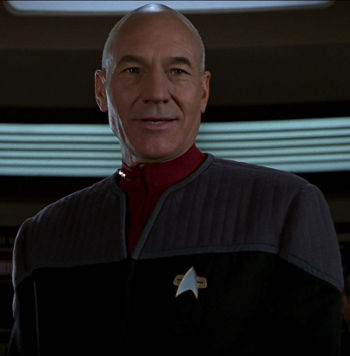
Jean-Luc Picard (ST-08)
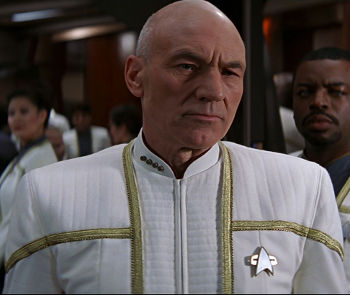
Jean-Luc Picard (ST-09)
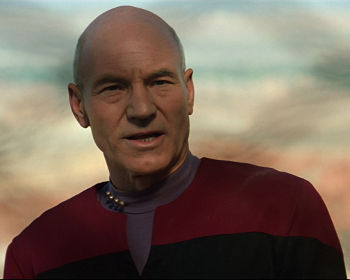
Jean-Luc Picard (ST-07)
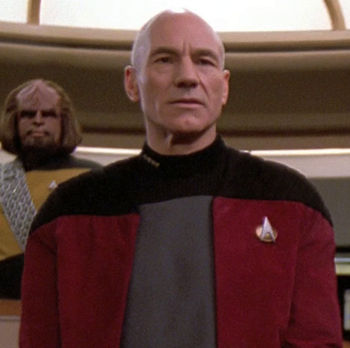
Jean-Luc Picard (TNG-225)

Locutus (ST-08)
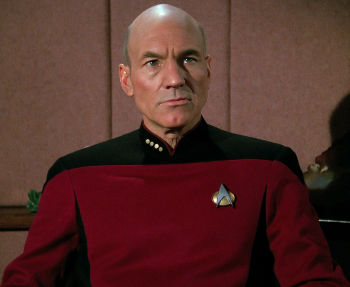
Jean-Luc Picard (TNG-165)
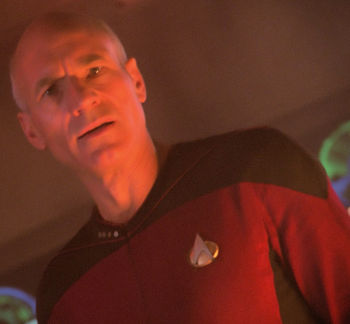
Jean-Luc Picard (TNG-110)
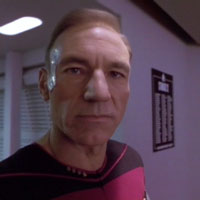
Jean-Luc Picard (TNG-212)
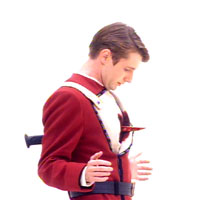
Jean-Luc Picard stabbed (TNG-241)
 Young Jean-Luc Picard (TNG-233)
Young Jean-Luc Picard (TNG-233)
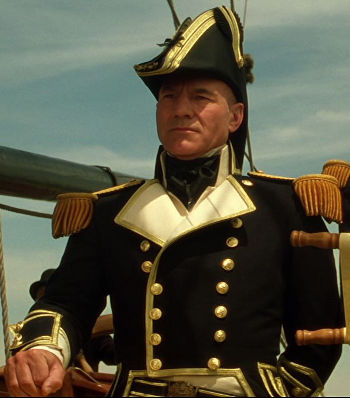
Jean-Luc Picard on holodeck (ST-07)
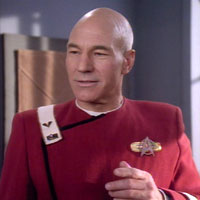
Jean-Luc Picard (TNG-241)
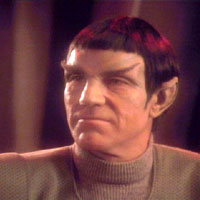
Jean-Luc Picard disguised as a Romulan (TNG-208)
Jean-Luc Picard was born in 2305, in the French town of Labarre on Earth.[17] His parents, Maurice Picard[17] and Yvette Gessard Picard,[2] were staunch traditionalists who brought him up with a very strong sense of his cultural roots and family history. The Picard family shunned modern technology such as replicators, and Maurice clearly hoped that Jean-Luc would stay in Labarre like his elder brother Robert.[17] Jean-Luc, however, was fascinated by space from an early age. He made several visits to the Smithsonian Institution, where he saw the Phoenix—the ship in which Zefram Cochrane made the first warp flight[33]—and he started building models of spaceships, such as a Promellian battle cruiser, in bottles.[11]
Jean-Luc excelled at school, always earning top marks,[17] and at 17 he applied to Starfleet Academy. He was rejected on his first attempt, but despite his father’s objections he reapplied the following year and was accepted.[4]
Picard had an extremely impressive career at the Academy, both as a sportsman and an academic. In his first year he won the 40 kilometer run on Danula II, becoming the first and only freshman to ever win the academy marathon.[16] He also excelled in his studies, particularly archaeology, which was taught by Professor Richard Galen. In fact, Galen was so impressed that he believed Picard could well have become the foremost archaeologist of his generation had he not pursued a career in Starfleet.[28]
While at the Academy, Picard forged close frienships with several people, including the groundskeeper Boothby, and his classmates Marta Batanides and Cortin Zweller.[27]
Despite his achievements, “Johnny” Picard was still somewhat immature. He had a reputation as a ladies’ man, and was known for making more than one date on the same day.[27] He also had some disciplinary problems, and on one occasion was almost expelled from the Academy (TNG-). But none of this seemed to interfere with his studies, and he graduated as class valedictorian in 2327.[10]
Shortly after graduation, Picard’s life changed radically. He and his frinds Cortin and Marta were at Starbase Earhart, on leave while waiting for their final assignments, when they were involved in a disagreement with three Nausicaans. Picard started a fight, and during the struggle he was stabbed through the heart. He survived the incident and was given an artificial heart, but it had a profound effect on his personality. He was now much more aware of his own mortality, and the seriousness of some of the risks he had been running. He became much more thoughtful, and even more determined to succeed.[27]
By 2333, Picard had been promoted to lieutenant commander, and was serving as second officer on the U.S.S. Stargazer NCC-2893 under Captain Ruhalter. When Ruhalter was killed and the first officer, Commander Leach, was incapacitated, Picard took command. Admiral Medhi was so impressed with his performance that he made the position permanent by promoting Picard to captain and giving him command of the Stargazer. At 28, Picard was one of the youngest men to ever earn his own command.[36]
Picard stayed in command of the Stargazer for 22 years, earning a reputation as one of the finest captains in Starfleet. He was assigned to deep space exploration, and although his mission was exciting, it was often dangerous.[3] One of Picard’s closest friends, Lieutenant Commander Jack Crusher, served under him, but was killed in 2354.[1] The Stargazer was almost lost on several occasions—during a mission to sector 21503, it barely survived a battle with Cardassian forces—and it was eventually irreparably damaged in 2355 during a skirmish with an unidentified vessel.[3]
The Stargazer had entered the Maxia Zeta system when it was attacked without warning. The crew survived only because Picard developed a new maneuver, involving a short warp-speed journey that confused the enemy’s sensors and allowed the Stargazer to fire a full spread of phasers and photon torpedoes at point-blank range, which completely destroyed the enemy vessel. Years later, it was learned that the attacking vessel was actually a Ferengi ship. The tactic used by Picard came to be known as the Picard Maneuver, and was taught at Starfleet Academy. Picard and his crew were forced to abandon the Stargazer in the shuttlecraft and escape pods, and limp back to Federation space.[3] Per standard procedure, Picard faced a preliminary hearing pursuant to a potential court-martial for the loss of the Stargazer, but he was exhonerated.[7]
In 2363, Picard was made captain of Starfleet’s newly-commissioned flagship, the Galaxy-class U.S.S. Enterprise NCC-1701-D.[1] He hand-picked many of his senior officers, requesting Geordi LaForge because he was impressed with the way the young man had completely overhauled a shuttle after Picard had made a casual remark (TNG-), and Lieutenant Tasha Yar because he had seen her perform heroically during a rescue mission on the planet Carnel (TNG-). Perhaps most significantly, Picard gave the position of first officer to Commander William Riker, who had previously served on the U.S.S. Hood NCC-42296 under Captain DeSoto. He chose Riker because a report showed that he had refused to allow DeSoto to beam into a dangerous situation, and he respected the young man’s willingness to stand up to his superiors.[1]
Shortly after assuming command of the Enterprise, Picard became the first Starfleet officer known to have encountered the super-being known as Q. The Enterprise had been sent to investigate Farpoint Station, where it was due to collect many of its senior staff, but en route it was intercepted by Q, who demanded that mankind stop its exploration of the galaxy. Picard refused, and became involved in a trial—with Q as judge and jury—in which mankind was accused of being a savage race. When Picard managed to persuade Q to judge mankind as it was, and not on its past behavior, the near-omnipotent being elected Picard to act as humanity’s representative. Picard’s actions at Farpoint satisfied Q,[1] but it was later revealed that the “trial” never ended.[30]
The Enterprise‘s first year in service was quite eventful. A few months after encountering Q, it was the first ship to make confirmed first contact with the Ferengi when it pursued a Ferengi Marauder into the Delphi Ardu system.[3] In March of 2364, Picard’s old friend Walker Keel contacted him, and warned him that he believed there was a high-level conspiracy in Starfleet Command. When Keel’s ship was lost in an “accident,” Picard took the Enterprise to Earth to investigate the conspiracy. When they arrived, Picard and his crew discovered that a race of alien parasites had taken control of many high-ranking officers. The Enterprise crew managed to destroy the parasites, saving the Federation.[5] In May of 2364, the Enterprise was sent to investigate the disappearance of several outposts along the edge of the Romulan Neutral Zone, and was the first Starfleet vessel to make contact with the Romulans in more than 50 years.[6]
The Enterprise was also the first Federation vessel known to have survived an encounter with the Borg. In early 2365, Q visited Picard, and transported the ship 7000 light years across space, where it met a Borg cube. Picard and his crew were not fully aware of the danger they were in and began to investigate the cube. The Borg responded by trying to assimilate the ship and its crew; the Enterprise survived the encounter only because it was rescued by Q. Whatever Q’s motives, the information that Picard and his crew gathered proved extremely valuable to Starfleet, which set up a task force to investigate ways of dealing with the Borg threat.[9]
When the Borg entered Federation space in mid-2366, the Enterprise was the first ship sent to investigate. During the mission, Picard was kidnapped by the Borg and taken to their ship.[15] What followed was deeply traumatic for him, and he suppressed memories of it for many years. Picard met the Borg Queen, who offered him the chance to join her by being assimilated in a way that would leave him with some of his individuality intact.[33] When he refused, he was forcibly assimilated, and became Locutus, a Borg spokesman.[15]
As Locutus, Picard was forced to give all of his tactical knowledge to the Borg, and the small part of him that remained human was forced to watch as the Borg destroyed dozens of Starfleet vessels at Wolf-359,[16] including the U.S.S. Saratoga NCC-31911.[31] Picard’s crew eventually rescued him. Lieutenant Commander Data and Counselor Troi managed to make contact with what was left of his humanity, and using his advice were able to send a signal to the Borg that made them enter their hibernation mode and, minutes later, destroy themselves.[16]
Although Picard’s physical wounds healed relatively quickly, the mental scars were far more serious. The Enterprise returned to Earth for repairs, and Picard decided to visit the Picard family vineyard for the first time in nearly two decades. His parents were long since dead, but his brother Robert continued to run the vineyard in the same old-fashioned way. While in France, Picard seriously considered leaving Starfleet to take up a position as the director of the Atlantis project, but he realized that his destiny lay with the Enterprise.[17]
It is clear that if Picard had so desired, he could easily have made a new career for himself; in 2363, he turned down the opportunity to become the commandant of Starfleet Academy[4] and he excelled in a number of fields. While he was posted to the Enterprise-D, he found time to maintain his archaeological studies, and in 2364 he visited the legendary planet of Iconia, where he uncovered their incredibly sophisticated technology.[8]
In 2366, during a holiday on Risa, Picard met the archaeologist Vash, who had found the Tox Uthat—a weapon from the 27th century that had been hidden in the past. When he realized how dangerous the device was, Picard made the decision to destroy it. Despite this, he and Vash remained on good terms.[14]
In 2368, Picard played a pivotal role in one of the most extraordinary archaeological finds in Federation history. The Enterprise was en route to Starbase 218 when it encountered an unidentified probe. When Picard began to investigate, the probe transmitted a low-level nucleonic beam that established a link with him and put him into a coma. During the 25 minutes that Picard was unconscious, he experienced an entire lifetime on the planet Kataan. He eventually discovered that Kataan had been destroyed a thousand years earlier, and that the natives had placed their memories in the probe in the hope that someday it would make contact with another race and their society would not be completely forgotten. The experience was extremely profound, and left Picard with the memories of a wife and children that he had never had.[24]
In 2369, Galen—Picard’s old archaeology professor—visited him on the Enterprise, and asked him to leave Starfleet to help him in his research. Picard reluctantly refused, but when Galen was killed shortly afterward he investigated his friend’s work and made an incredibly important discovery: many of the humanoid races in the galaxy had a common ancestor, which deliberately placed a message in their DNA.[28]
Picard also developed a formidable repuation as a legal advocate. While he was on the Enterprise, he played a vital role in establishing the legal rights of Soong-type androids. In 2364, Commander Bruce Maddox persuaded Starfleet Command to transfer Lieutenant Commander Data—the only Soong-type android known to exist at the time—to his command. Data, who was serving as Picard’s operations officer, refused. This led to a legal hearing in which Maddox maintained that Data was Starfleet’s property. Picard defended Data, and won a landmark judgment that established the android as sentient, and gave him full rights under Federation law.[7] When Admiral Haftel attempted to test that law by taking control of Data’s “daughter” Lal in 2366, Picard was ready to challenge his decision, but Lal died before matters could be resolved.[12]
Picard also earned an impressive repuatation as a diplomat; he helped to resolve countless disputes, and handled numerous first-contact situations. Some of Picard’s most important political achievements relate to the Klingons, with whom he had been deeply involved since the mid-2360s. In 2366, he helped Lieutenant Worf defend himself on Qo’noS when the Klingon officer learned that his father, Mogh, had been falsely implicated in the Romulan attack on Khitomer in 2346. During the trial, Picard acted as Worf’s cha’DIch, and uncovered evidence which proved that the House of Duras had framed Worf to conceal their own involvement with the Romulans.The Klingon chancellor, K’mpec, was unwilling to make this information public, but Picard’s honorable conduct impressed him.[13]
When K’mpec discovered later that year that he had been poisoned and was dying, he decided that the election of the new chancellor should be officiated by someone outside the Klingon Empire. From their dealings, he knew that Picard was an honorable man who understood the Klingons, so he found the Enterprise and made the captain his Arbiter of Succession; Picard was the only human to ever hold the office.[18] Following K’mpec’s death, Picard exposed Duras‘ relationship with the Romulans, and ensured that Gowron became the new chancellor.[19] Although the Prime Directive prevented Picard from becoming involved in the civil war that followed, he led the fleet which blockaded key systems along the Romulan border, preventing the Romulans from sending supplies to the House of Duras. As a result, Gowron won the civil war.[20]
Picard also played a vital role in disrupting a Romulan plot to invade Vulcan in 2367. When Starfleet learned that Ambassador Spock had apparently defected to Romulus, they sent Picard and Data to investigate. Using Picard’s relationship with the Klingons, they procured the use of a cloaked Klingon Bird of Prey for the mission. On arrival, they found Spock, who had made the journey in the hope of negotiating a peaceful reunification between the Vulcan and Romulan peoples.[21] Spock had, in fact, been lured to Romulus by Commander Sela, who planned to fake a message from him that would convince the Federation to allow an invasion fleet into their space. Picard, Data, and Spock were able to frustrate the plot, and the Enterprise officers returned to their ship, while Spock remained on Romulus to work with the Romulan underground movement.[22]
In 2368, Picard was presented with the opportunity to attack the Borg. The Enterprise discovered a crashed Borg scout ship, and recovered a Borg drone who had survived the accident. Picard still had very strong feelings about the Borg, and was determined to inflict as much damage on them as he could. Under his orders, the Enterprise crew developed an invasive program, which they believed they could use to cripple the Borg by introducing it to the stranded drone. However, while the drone was on the Enterprise, Picard was forced to reconsider his attitudes to the Borg collective. Due to his own experience of recovering from assimilation, he was convinced that the Borg could not be redeemed, but when he saw how the drone developed a sense of his own identity and started to call himself Hugh, Picard realized that he was allowing his anger to cloud his judgment. He took the decision to abandon his plan, and allowed Hugh to return to the collective without the destructive program.[23] This decision was later harshly criticized by Admiral Nechayev, but Picard remained convinced that he had done the right thing, and he later learned that Hugh had not only retained his sense of identity, he had “infected” the other drones on his cube with a sense of individuality as well.[29]
The Borg were not the only race who inflicted suffering on Picard. In late 2368, he was captured by the Cardassians while on an espionage mission, and during his captivity he was brutally tortured by Gul Madred.[25] Although political developments led to his release before he gave them any information, he confessed that if he had been captive much longer, he would have done anything Madred ordered.[26]
In 2371, the Enterprise-D was destroyed after Picard had left the ship in order to stop Dr. Tolian Soran from destroying the Veridian star. While he was gone, the Duras sisters, Lursa and B’Etor, managed to destroy the ship’s stardrive section, forcing the crew to make an emergency landing in the saucer section. Meanwhile, Picard followed Soran into a reality known as the Nexus, where dreams become reality. Picard and Captain James T. Kirk, whom he found there, chose to leave the Nexus in order to stop Soran.[32] Picard and his crew were soon given a new ship—the U.S.S. Enterprise NCC-1701-E—and spent the next year on a shakedown cruise.[33]
Even at this stage of his career, Picard believed in disobeying orders that he felt were unjustified. When a Borg ship tried to invade Earth in 2373, his superiors were concerned that his experiences as Locutus would make him unreliable, so they assigned the Enterprise to patrol the Romulan Neutral Zone. But Picard disobeyed orders and joined the fleet that was defending Earth when it became apparent that the Borg onslaught would not be stopped. When Admiral Hayes‘ ship was destroyed, Picard assumed command of the fleet, and used his knowledge to destroy the Borg cube. He then pursued a Borg sphere into Earth’s past, where he finally defeated the Borg and prevented them from altering the timeline so that the Federation would never have come into existence.[33]
Picard disobeyed orders again in 2374. When Lieutenant Commander Data apparently malfunctioned on a mission in the Briar Patch, Picard decided to investigate for himself. When he arrived, he discovered that senior Starfleet officers were involved in a conspiracy with the Son’a to harvest lifegiving energy from a planet inhabited by the Ba’ku. The plan was clearly unethical—it would have left the Ba’ku world uninhabitable—and Picard felt he had no choice but to disobey a direct order from Admiral Dougherty and intervene on the Ba’ku’s behalf. Dougherty was killed by the Son’a leader Ru’afo during the incident, but Picard managed to save the planet. He then persuaded the Federation council to halt their attempt to relocate the Ba’ku, proving that he was, as ever, the model Starfleet officer.[34] Portrayed by Sir Patrick Stewart.
References
- 1. “Encounter at Farpoint.” Star Trek: The Next Generation, Episode 101-102. Television. 28 September 1987.
- 2. “Where No One Has Gone Before.” Star Trek: The Next Generation, Episode 106. Television. 26 October 1987.
- 3. “The Battle.” Star Trek: The Next Generation, Episode 110. Television. 16 November 1987.
- 4. “Coming of Age.” Star Trek: The Next Generation, Episode 119. Television. 14 March 1988.
- 5. “Conspiracy.” Star Trek: The Next Generation, Episode 125. Television. 9 May 1988.
- 6. “The Neutral Zone.” Star Trek: The Next Generation, Episode 126. Television. 16 May 1988.
- 7. “The Measure of a Man.” Star Trek: The Next Generation, Episode 135. Television. 13 February 1989.
- 8. “Contagion.” Star Trek: The Next Generation, Episode 137. Television. 20 March 1989.
- 9. “Q Who?” Star Trek: The Next Generation, Episode 142. Television.
- 10. “Samaritan Snare.” Star Trek: The Next Generation, Episode 143. Television. 15 May 1989.
- 11. “Booby Trap.” Star Trek: The Next Generation, Episode 154. Television. 30 October 1989.
- 12. “The Offspring.” Star Trek: The Next Generation, Episode 164. Television. 12 March 1990.
- 13. “Sins of the Father.” Star Trek: The Next Generation, Episode 165. Television. 19 March 1990.
- 14. “Captain’s Holiday.” Star Trek: The Next Generation, Episode 167. Television. 2 April 1990.
- 15. “The Best of Both Worlds.” Star Trek: The Next Generation, Episode 174. Television. 18 June 1990.
- 16. “The Best of Both Worlds, Part II.” Star Trek: The Next Generation, Episode 175. Television. 24 September 1990.
- 17. “Family.” Star Trek: The Next Generation, Episode 178. Television. 1 October 1990.
- 18. “Reunion.” Star Trek: The Next Generation, Episode 181. Television. 5 November 1990.
- 19. “Redemption.” Star Trek: The Next Generation, Episode 200. Television. 17 June 1991.
- 20. “Redemption, Part II.” Star Trek: The Next Generation, Episode 201. Television. 23 September 1991.
- 21. “Unification, Part I.” Star Trek: The Next Generation, Episode 208. Television. 4 November 1991.
- 22. “Unification, Part II.” Star Trek: The Next Generation, Episode 207. Television. 11 November 1991.
- 23. “I, Borg.” Star Trek: The Next Generation, Episode 223. Television. 11 May 1992.
- 24. “The Inner Light.” Star Trek: The Next Generation, Episode 225. Television. 1 June 1992.
- 25. “Chain of Command, Part I.” Star Trek: The Next Generation, Episode 236. Television. 14 December 1992.
- 26. “Chain of Command, Part II.” Star Trek: The Next Generation, Episode 237. Television. 21 December 1992.
- 27. “Tapestry.” Star Trek: The Next Generation, Episode 241. Television. 15 February 1993.
- 28. “The Chase.” Star Trek: The Next Generation, Episode 246. Television. 26 April 1993.
- 29. “Descent, Part II.” Star Trek: The Next Generation, Episode 253. Television. 20 September 1993.
- 30. “All Good Things….” Star Trek: The Next Generation, Episode 277-278. Television. 23 May 1994.
- 31. “Emissary.” Star Trek: Deep Space Nine, Episode 401-402. Television. 4 January 1993.
- 32. Star Trek: Generations. Film. 18 November 1994.
- 33. Star Trek: First Contact. Film. 22 November 1996.
- 34. Star Trek: Insurrection. Film. 11 December 1998.
- 35. Star Trek: Nemesis. Film. 13 December 2002.
- 36. “The Valiant.” Star Trek: The Next Generation (Unnumbered). Novel. April 2000.
1 Comment to Picard, Jean-Luc
Leave a Reply
Categories
- Animated Series (60)
- Articles (28)
- Books (447)
- Cast & Crew (79)
- Comics (22)
- DS9 (328)
- Early Voyages (125)
- Education (5)
- Enterprise (373)
- Excelsior (36)
- Food (19)
- Games (223)
- Klingon (70)
- Library (1,543)
- Logs (593)
- Lost Era (55)
- Medicine (18)
- Merrimac (1)
- Mirror (35)
- Miscellaneous (13)
- New Frontier (54)
- Next Generation (635)
- Original Series (681)
- Personnel (436)
- Places (369)
- Politics (12)
- Recreation (10)
- SCE (41)
- Science (1)
- Shatnerverse (9)
- Ships (455)
- Site Updates (98)
- Starfleet Academy (86)
- Stargazer (42)
- STO (61)
- Technology (45)
- Titan (59)
- To Boldly Go (1)
- TV/Film (214)
- Uncategorized (4)
- Vanguard (76)
- Voyager (236)
- Weapons (27)
- Xenology (54)
[…] she was wearing a renaissance faire dress, tying it into Star Trek via an episode where Q forced Captain Picard and his crew to play out the roles of Robin Hood and his Merry Men (leading to one of Lt. […]